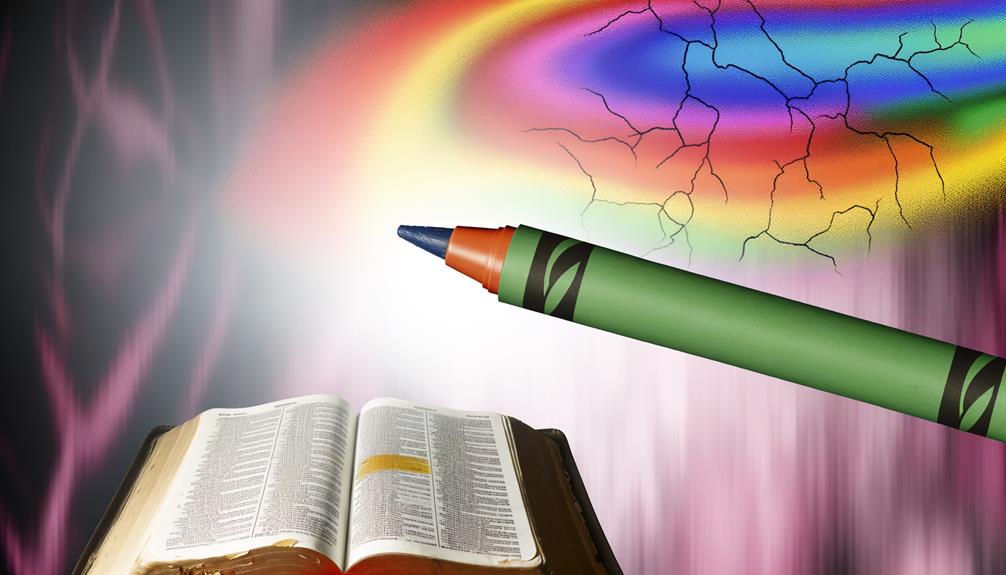Broken Crayons Still Color Meaning Bible: Redemption!
The phrase ‘broken crayons still color‘ vividly encapsulates a core biblical truth: God’s ability to use flawed individuals for His purposes. Scripture abundantly showcases this theme.
Moses, despite feeling inadequate due to his speech impediment (Exodus 4:10-12), led Israel out of bondage. King David, flawed by moral failures, was still ‘a man after God’s own heart’ (1 Samuel 13:14).
Apostle Paul shifted from persecutor to a pivotal church leader, strengthened by God’s grace (2 Corinthians 12:9). Peter’s denial of Jesus (Matthew 26:69-75) culminated in his restoration and leadership role (John 21:15-19).
God’s transformative power in weakness allows deeply meaningful theological reflections.

Key Takeaways
- God often uses flawed individuals to fulfill His divine purposes, exemplified by Moses, David, Paul, and Peter.
- Human imperfections and failures do not hinder God’s plans, as His grace empowers and transforms.
- Despite significant moral failings, figures like David and Peter were restored and continued to serve God’s purpose.
- Paul’s conversion story illustrates that no one is beyond God’s redeeming grace, highlighting transformation and purpose.
Biblical Meaning of “Broken Crayons Still Color”: Redemption, Purpose, and Restoration
| Interpretation | Meaning | Explanation |
|---|---|---|
| Redemption and Healing | Symbolizes that even in brokenness, God can still use you for His purpose. | Just as broken crayons still color, this phrase reflects the biblical message of redemption—God can restore and use people despite their past hurts or failures (Isaiah 61:3). |
| God’s Strength in Weakness | Reflects how God’s strength is made perfect in our weakness. | The Bible teaches that God’s power is often most evident when we are weak or broken, as in 2 Corinthians 12:9, where Paul says, “My grace is sufficient for you, for my power is made perfect in weakness.” |
| Purpose Despite Imperfection | Demonstrates that imperfections don’t hinder God’s plan. | Brokenness does not disqualify you from God’s purpose. Just as broken crayons can still color, people can still fulfill their God-given purpose despite their flaws (Romans 8:28). |
| Hope and Renewal | Encourages faith that God can bring beauty from brokenness. | The phrase reflects biblical themes of hope and renewal, emphasizing that God can turn brokenness into something beautiful (Jeremiah 18:4). |
| Resilience and Restoration | Shows resilience through God’s restorative power. | Just like broken crayons continue to color, people can still contribute meaningfully in life through God’s healing and restoration (Psalm 147:3). |
Biblical Examples of Imperfection

Drawing from the rich tapestry of scripture, one can observe numerous instances where God uses imperfect individuals to fulfill His divine purposes.
For example, Moses, who despite his speech impediment, was chosen to lead the Israelites out of Egypt (Exodus 4:10-12).
Similarly, David, a shepherd boy with a flawed moral compass, rose to become Israel’s greatest king and a man after God’s own heart (1 Samuel 13:14).
The Apostle Paul, once a persecutor of Christians, became a cornerstone of the early Church, emphasizing God’s power in human weakness (2 Corinthians 12:9).
These instances underscore a profound theological truth: God’s sovereignty and grace transcend human frailty, using broken vessels to achieve His redemptive plan throughout history.
Moses: Doubts and Destiny

Moses, plagued by self-doubt and insecurity as evidenced in Exodus 4:10, questioned his own ability to fulfill God’s command.
Yet, his journey from hesitant shepherd to leader of the Israelites underscores a divinely orchestrated purpose, manifesting God’s power through human frailty.
This transformation, deeply rooted in historical and scriptural context, illustrates how divine grace can elevate even the most reluctant individuals to fulfill their destiny.
Moses’ Early Hesitations
When God first called Moses through the burning bush, Moses exhibited significant hesitations, rooted in his self-perceived inadequacies and fear of rejection (Exodus 3:11; 4:1).
His initial doubts reveal a profound human struggle against divine calling. Historically, Moses’ reluctance can be understood in the context of his past, including his exile from Egypt and his identity crisis as a Hebrew raised in Pharaoh’s household.
- Self-Doubt: Moses questioned his worthiness and ability to lead (Exodus 3:11).
- Fear of Rejection: He worried the Israelites would not believe God had sent him (Exodus 4:1).
- Speech Impediment: Moses expressed concern over his eloquence, fearing it would hinder his mission (Exodus 4:10).
These hesitations highlight God’s use of imperfect instruments for divine purposes.
Divine Purpose Revealed
Despite Moses’ initial hesitations, God’s revelation of His divine purpose for Moses’ life demonstrated that human frailties do not hinder divine plans (Exodus 3:12; 4:12).
When God called Moses from the burning bush, Moses doubted his ability to lead Israel out of Egypt, citing his lack of eloquence (Exodus 4:10). Nevertheless, God assured him, ‘I will be with you’ (Exodus 3:12), emphasizing divine empowerment over human weakness.
Historically, Moses’ journey from a fugitive shepherd to the leader of a nation illustrates the transformative power of divine intervention.
God’s promise to guide Moses’ speech (Exodus 4:12) underscores the theological principle that God’s purposes transcend human limitations, revealing a destiny shaped not by human capacity but by divine will.
David: Flaws and Faith

King David, though celebrated as a man after God’s own heart (1 Samuel 13:14), was not without significant flaws, including his moral failings with Bathsheba (2 Samuel 11).
Despite these imperfections, his unwavering trust in God, as exemplified in the Psalms, highlights a profound faith that transcends his human weaknesses.
This juxtaposition of David’s frailty and fervent devotion provides a compelling narrative of divine grace and redemption throughout biblical history.
David’s Human Imperfections
Although David is celebrated as a man after God’s own heart, his life was marred by significant flaws and moral failures, as documented in the scriptures. His story elucidates the complexities of human imperfection and divine grace.
- Adultery with Bathsheba (2 Samuel 11:2-5): David’s illicit relationship with Bathsheba led to a series of grievous sins, including deceit and murder.
- Census of Israel (2 Samuel 24:10): David’s decision to conduct a census, driven by pride, incurred God’s wrath, resulting in a devastating plague.
- Family Discord (2 Samuel 13): David’s failure to address the sins within his family, such as Amnon’s assault on Tamar, led to tragic consequences and internal strife.
David’s imperfections remind us that even the anointed can falter, yet God’s grace remains steadfast.
Unwavering Trust in God
David’s unwavering trust in God, even amid his profound flaws, is exemplified in his heartfelt prayers and psalms, such as in Psalm 23, where he declares, ‘The Lord is my shepherd; I shall not want.’ This declaration reveals a deep, personal relationship with God, illustrating a faith that transcends his human imperfections.
Historically, David’s life was marked by significant moral failures, including his sins with Bathsheba (2 Samuel 11) and his orchestration of Uriah’s death. Despite these transgressions, David’s reliance on God’s mercy and guidance remained steadfast.
His penitential Psalm 51 shows his profound repentance and trust in God’s unfailing love. Consequently, David’s life embodies the theological truth that divine grace can work through human brokenness.
Paul: Transformation and Purpose

Frequently, the Apostle Paul’s transformation on the road to Damascus serves as a profound witness to the redemptive power of divine grace, as recounted in Acts 9:1-19. This pivotal moment not only marked a radical change in Paul’s life but also underscored the transformative potential inherent in every believer.
Paul’s mission thereafter illuminates key theological principles:
- Redemption: Paul’s conversion illustrates that no one is beyond the reach of God’s grace (1 Timothy 1:15-16).
- Purpose: His subsequent ministry demonstrates how God can repurpose even the most flawed individuals for divine missions (Galatians 1:15-16).
- Endurance: Paul’s trials and perseverance highlight the strength derived from a purpose-driven life (2 Corinthians 11:23-28).
Through Paul, we grasp the profoundity of purpose in God’s plan.
Peter: Denial and Redemption

Peter’s three denials of Jesus, as recounted in the synoptic Gospels (Matthew 26:69-75, Mark 14:66-72, Luke 22:54-62), culminate in the poignant moment when the rooster crows, fulfilling Jesus’ prophecy and symbolizing Peter’s profound failure.
This event, set against the backdrop of a hostile Jerusalem during Passover, underscores the frailty of human resolve under divine scrutiny.
Yet, Peter’s path to redemption, poignantly illustrated in John 21:15-19, exemplifies the transformative power of Christ’s forgiveness and the restoration of one’s purpose in the early Church.
Peter’s Three Denials
How does one reconcile the profound moment of Peter’s three denials with the overarching narrative of his ultimate redemption and leadership within the early Church?
Peter’s denials, as recorded in the Gospels (Matthew 26:69-75, Mark 14:66-72, Luke 22:54-62, John 18:15-27), serve as a poignant reminder of human frailty. Yet, his later restoration, particularly in John 21:15-19, underscores divine grace and the transformative power of forgiveness.
This narrative highlights several key themes:
- Human Weakness: Peter’s denials reflect our capacity for failure, even among the most devoted followers.
- Divine Grace: Christ’s forgiveness post-resurrection illustrates unmerited favor.
- Restoration: Peter’s reinstatement symbolizes the potential for new beginnings and leadership despite past failures.
These elements collectively affirm that brokenness can lead to profound spiritual renewal.
Rooster’s Crowing Significance
In the narrative of Peter’s denial, the crowing of the rooster stands as a prophetic signifier, encapsulating both the foreknowledge of Christ and the moment of Peter’s profound self-realization and contrition (Matthew 26:34, 75).
Jesus’ prediction of Peter’s threefold denial before the rooster crows underscores His divine omniscience. Historically, the rooster’s crow marked the end of the third watch of the night, a critical moment of change.
For Peter, this auditory cue precipitated a poignant awareness of his frailty and failure. Theologically, it invites reflection on human weakness juxtaposed against divine foreknowledge and mercy.
As the rooster crowed, Peter’s tears symbolized his deep remorse, setting the stage for his eventual restoration and reinforcing the perpetual possibility of redemption.
Path to Redemption
The rooster’s crow not only marked Peter’s moment of remorse but also initiated his journey toward redemption, highlighting the transformative power of divine grace as seen through Christ’s subsequent restoration of Peter (John 21:15-17). This path to redemption reveals several profound truths:
- Repentance: Peter’s weeping after his denial (Luke 22:62) signifies genuine repentance, a vital step toward receiving God’s forgiveness.
- Restoration: Jesus’ thrice-repeated question, ‘Do you love me?’ (John 21:15-17), mirrors Peter’s three denials, symbolizing full restoration and reinstatement of his apostolic mission.
- Commission: Christ’s directive to ‘feed my sheep’ entrusts Peter with shepherding the early Church, underscoring that even those who falter can be powerful instruments of God’s purpose.
These elements underscore the redemptive power inherent in divine grace and forgiveness.
God’s Grace for the Broken

Even in our most fractured and vulnerable states, God’s grace remains steadfast and unyielding, as evidenced throughout scripture, from the restoration of Peter after his denial of Christ (John 21:15-17) to the redemption of the apostle Paul, formerly Saul, whose transformation is detailed in Acts 9.
These narratives illustrate that divine grace transcends human frailty and sin. Peter’s reinstatement by Jesus, symbolized through the thrice-repeated question, ‘Do you love me?’ reflects the boundless mercy available to the contrite heart.
Similarly, Paul’s conversion from a persecutor to a proclaimer of the gospel underscores God’s power to repurpose broken lives for His glory.
Historical context reveals that grace operates not as a fleeting emotion but as a cornerstone of Christian redemption.
Strength in Weakness

Scripture consistently affirms that true strength is often revealed through our weaknesses, as evidenced by Paul’s declaration in 2 Corinthians 12:9, ‘My grace is sufficient for you, for my power is made perfect in weakness.’ This paradoxical truth is echoed throughout biblical history:
- Gideon’s Victory (Judges 7:2-7): God reduced Gideon’s army to a mere 300 men to guarantee that Israel’s triumph could only be attributed to divine strength.
- David vs. Goliath (1 Samuel 17): The young shepherd defeated the giant not by physical prowess but by his faith in God’s power.
- Jesus’ Crucifixion (Philippians 2:8-9): Christ’s ultimate act of weakness on the cross paved the way for the resurrection, demonstrating divine strength.
Understanding these instances helps us see how God’s power is magnified in human frailty.
Purpose Beyond Failure

Recognizing God’s providential hand in our failures reveals a deeper purpose that transforms our setbacks into stepping stones for spiritual growth and divine alignment.
The Apostle Paul elucidates this in Romans 8:28, asserting that God works all things for the good of those who love Him.
Historical figures like King David, who faced moral failures, illustrate how divine purpose can emerge from human frailty (2 Samuel 11-12).
Similarly, Peter’s denial of Christ (Luke 22:54-62) became a conduit for his eventual leadership and strengthening of the early Church.
These instances underscore that failure, under divine providence, is not an endpoint but a transformative process, realigning us with God’s sovereign will and deeper spiritual maturity.
Healing Through Brokenness

As we reflect on how divine providence transforms our failures into avenues for growth, we see that it is within our brokenness that true healing and restoration often begin. Scripture provides profound examples of this transformative power.
- David’s Repentance: After his grievous sins, David’s broken heart led to profound repentance (Psalm 51), illustrating how sorrow can lead to spiritual renewal.
- Paul’s Weakness: Paul’s admission of his thorn in the flesh (2 Corinthians 12:9) reveals that God’s strength is made perfect in our weaknesses.
- Peter’s Restoration: Peter’s denial of Christ and subsequent restoration (John 21:15-19) show how failure can precede a deeper, more resilient faith.
These examples underscore how biblical brokenness can lead to divine healing.
Embracing Our Imperfections

Embracing our imperfections is an essential aspect of spiritual growth, as it allows us to experience God’s grace more profoundly, much like how the apostle Paul found strength in his weaknesses (2 Corinthians 12:9).
This theological insight is rooted in the recognition that human frailty is not a barrier to divine love but a conduit for it.
Throughout biblical history, imperfect figures like Moses, David, and Peter were pivotal in God’s plan, underscoring that divine purpose often thrives in human weakness.
Augustine of Hippo, in his *Confessions*, articulated that acknowledging our flaws brings us closer to God’s redemptive power.
Consequently, embracing our imperfections aligns with the biblical narrative, fostering a deeper reliance on God’s transformative grace.
Conclusion
In summation, the scriptural narrative abundantly affirms that flawed figures—Moses, David, Paul, and Peter—demonstrate divine deliverance and destiny. Their stories of repentance, redemption, and restoration provide evidence of God’s merciful and transformative power. By closely examining these flawed figures, one can gain a comprehensive understanding of the bible and how God’s plan unfolds through imperfect vessels. Their experiences serve as a reminder that no matter our shortcomings, God can still use us for his purposes and ultimately fulfill our destinies.
Their stories underscore that strength is often forged in frailty, with brokenness birthing blessedness.
Biblical accounts reveal that imperfections do not impede divine purpose but rather propel it.
Consequently, embracing human imperfections and drawing from divine strength underscores the theological truth: broken crayons still color, illustrating that divine grace transforms human weaknesses into wondrous works.






